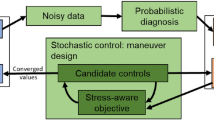Abstract
Digital twin is a generic term used across disciplines to mean a digital copy of a physical entity. Facilitated by the new generation of information technology, the digital twin has drawn more and more attention from both academia and industry. Especially, as predicted in many studies, this technique has great potential to bring innovative and revolutionary changes for aerospace. This chapter gives a general introduction of digital twin. Furthermore, its application for the maintenance, repair, and overhaul of aircraft is outlined. In this chapter, first of all, the concept of digital twin is introduced, including its generation, development, and general components. Then, the maintenance process for aircraft as well as the existing issues is described. After that, the digital twin with the application of aircraft maintenance is elaborated from the perspectives of concept, system architecture, and system implementation. Subsequently, three cases are presented to illustrate how this digital twin works in the health status evaluation, future health status prediction, and maintenance activity management. At last, the summary of this chapter is made, along with a review about the challenges faced for implementing digital twin technology in aerospace.
Access this chapter
Tax calculation will be finalised at checkout
Purchases are for personal use only
Similar content being viewed by others
References
Grieves M. Digital twin: manufacturing excellence through virtual factory replication. White Paper. 2014;1:1–7.
Tao F, Meng Z. Digital twin shop-floor: a new shop-floor paradigm towards smart manufacturing. IEEE Access. 2017;5:20418–27.
Zhuang CB, Liu JH, **ong H, Ding X, Liu S, Weng G. Connotation, architecture and trends of product digital twin. Comput Integr Manuf. 2017;23(4):753–68.
Weyer S, Meyer T, Ohmer M, Gorecky D, Zühlke D. Future modeling and simulation of CPS-based factories: an example from the automotive industry. IFAC-PapersOnLine. 2016;49(31):97–102.
**song Y, Yue S, Tang Diyin A. Digital twin approach based on nonparametric Bayesian network for complex system health monitoring. J Manuf Syst. 2020; https://doi.org/10.1016/j.jmsy.2020.07.005.
Hamad Al-kaabi AP, Naim M. An outsourcing decision model for airlines’ MRO activities. J Qual Maint Eng. 2007;13(3):217–27.
Jalil D, Bakar S, Khir M, Fauzi M. Integrated facility platform for next-gen aircraft maintenance, repair and overhaul (MRO). Int J Comput Sci Inf Secur. 2017;15(5):356–62.
Maurice P. Data mining for aircraft maintenance repair and overhaul (MRO). 2019. http://www.amsterdamuas.com/binaries/content/assets/subsites/aviation/data-miningin-mro/190417-data-mining-for-mro-presentation-final-s.pdf?1559025732768. Accessed 17 Apr 2019.
Nadine E. How MRO is unlocking huge opportunities for digital twins in aviation. 2019. https://www.aviationtoday.com/2019/03/26/mro-unlocking-huge-opportunities-digitaltwins-aviation. Accessed 26 Mar 2019.
Wang L, Ranjan R, Chen J, Benatallah B. Cloud computing: methodology, systems, and applications. London: CRC Press; 2017.
Hugh R. MRO 4.0: The next big step for processes – using digital twins and location. 2019. http://www.aircraftit.com/articles/improving-business-efficiency-in-an-mro-environment. Accessed 15 Apr 2019.
Iorga M, Feldman L, Barton R, Martin M, Goren N, Mahmoudi C. The nist definition of fog computing. No. NIST Special Publication (SP) 800–191 (Draft). Natl Inst Stand Technol. 2017; https://doi.org/10.6028/NIST.SP.500-325. Accessed 15 March 2018.
Liao M, Guillaume R, Yan B. Airframe digital twin technology adaptability assessment and technology demonstration. Eng Fract Mech. 2020;225:1–15.
Li C, Mahadevan S, Ling Y, Choze S, Wang L. Dynamic Bayesian network for aircraft wing health monitoring digital twin. AIAA J. 2017;55(3):930–41.
Hua W, Hou J, Jiang Z. Fault diagnosis and prognostic methods based on hybrid system theory for MEHI systems in aircraft. Appl Mech Mater. 2013;389:550–5.
Liu Z, Norbert M, Nezih M. The role of data fusion in predictive maintenance using digital twin. AIP Conf Proc. 2018;1949(1):1–6.
Millwater H, Juan O, Nathan C. Probabilistic methods for risk assessment of airframe digital twin structures. Eng Fract Mech. 2019;221:1–24.
García C, Teresa E, Joseba Q. PHM techniques for condition-based maintenance based on hybrid system model representation. Proc Annu Conf Progn Health Manag Soc. 2010:1–8.
Carboni M, Stefano C. Advanced ultrasonic “probability of detection” curves for designing in-service inspection intervals. Int J Fatigue. 2016;86:77–87.
Lei Y, Li N, Guo L, Li N, Yan T, Lin J. Machinery health prognostics: a systematic review from data acquisition to RUL prediction. Mech Syst Signal Process. 2018;104:799–834.
Lincoln J. Method for computation of structural failure probability for an aircraft. No. ASDTR- 80-5035. In: Aeronautical systems div wright-Patterson afb oh; 1980.
Glaessgen E. David S. the digital twin paradigm for future NASA and US air force vehicles. 14th AIAA Conf Proc. 2012:1–14.
Basri EI, Razak IHA, Ab-Samat H, Kamaruddin S. Preventive maintenance (PM) planning: a review. J Qual Maint Eng. 2017;23(2):114–43.
Seshadri B, Thiagarajan K. Structural health management of damaged aircraft structures using digital twin concept. 25th AIAA Conf Proc. 2017;1–13
Paris P. Fazil E. a critical analysis of crack propagation laws. J Basic Eng. 1963;85(4):528–33.
Cochran JK, Horng SM, Fowler JW. A multi-population genetic algorithm to solve multi-objective scheduling problems for parallel machines. Comput Oper Res. 2003;30(7):1087–102.
Author information
Authors and Affiliations
Corresponding author
Editor information
Editors and Affiliations
Section Editor information
Rights and permissions
Copyright information
© 2022 Springer Nature Switzerland AG
About this entry
Cite this entry
Wang, T., Liu, Z. (2022). Digital Twin and Its Application for the Maintenance of Aircraft. In: Meyendorf, N., Ida, N., Singh, R., Vrana, J. (eds) Handbook of Nondestructive Evaluation 4.0. Springer, Cham. https://doi.org/10.1007/978-3-030-73206-6_7
Download citation
DOI: https://doi.org/10.1007/978-3-030-73206-6_7
Published:
Publisher Name: Springer, Cham
Print ISBN: 978-3-030-73205-9
Online ISBN: 978-3-030-73206-6
eBook Packages: Chemistry and Materials ScienceReference Module Physical and Materials ScienceReference Module Chemistry, Materials and Physics




